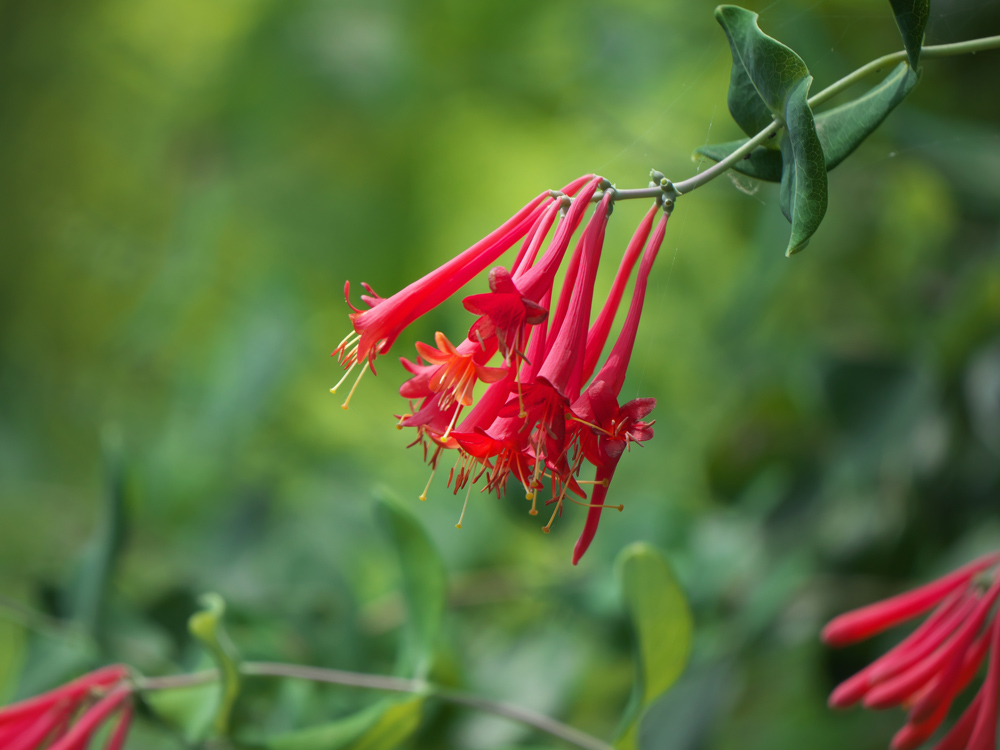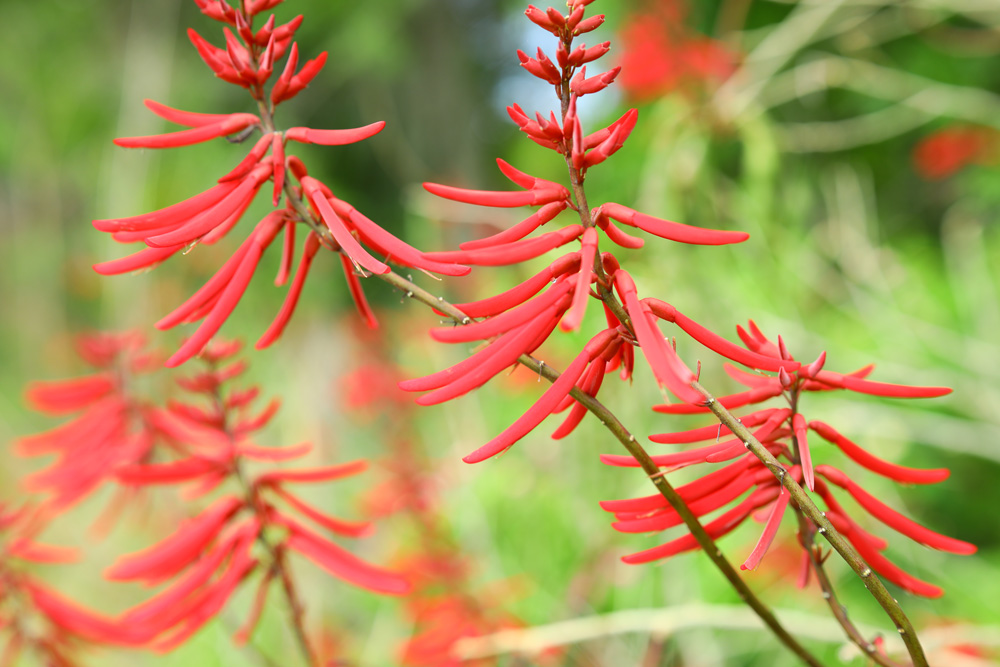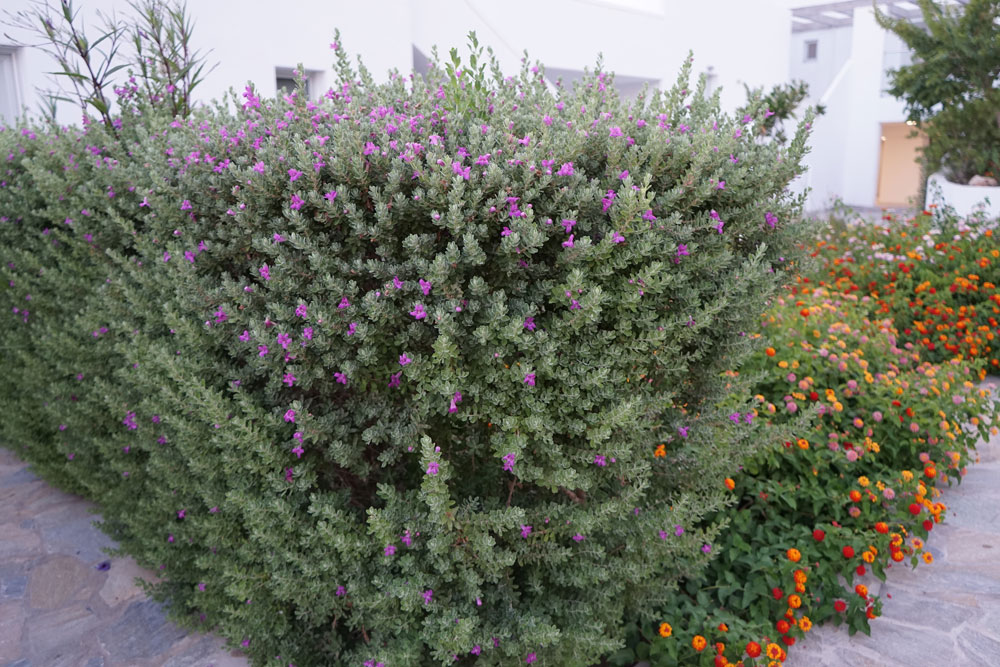
Are you looking to add a touch of magic to your Florida garden? Imagine tiny, iridescent birds hovering around vibrant flowers, their wings beating so fast they’re almost invisible. That’s the joy hummingbirds can bring to your outdoor space!
In this guide, we’ll explore 15 fantastic plants that are sure to turn your garden into a hummingbird haven. We’ll cover both native Florida species and some non-native (but Florida-friendly) options that these enchanting little visitors simply can’t resist.
Let’s dive in and discover how to create a buzzing, blooming paradise for hummingbirds right in your own backyard!
Native Florida Plants
1. Firebush (Hamelia patens)

Want to set your garden ablaze with color and hummingbird activity? Look no further than the firebush! This fast-growing shrub is a hummingbird magnet, thanks to its clusters of bright red, tubular flowers.
Firebush blooms almost year-round in South Florida, providing a constant nectar source. It’s also low-maintenance and drought-tolerant once established, making it a perfect choice for busy gardeners.
2. Coral Honeysuckle (Lonicera sempervirens)

Imagine a vine that’s both beautiful and beneficial – that’s coral honeysuckle for you! This native climber produces trumpet-shaped red flowers that hummingbirds find irresistible.
Coral honeysuckle is perfect for trellises, fences, or allowed to ramble as a ground cover. Unlike its invasive cousin, Japanese honeysuckle, this native variety plays well with others in your garden ecosystem.
3. Tropical Sage (Salvia coccinea)

Looking for a pop of color that hummingbirds can’t ignore? Tropical sage is your answer! This native perennial boasts spikes of vibrant red flowers that bloom prolifically, especially in partial shade.
Drought-tolerant and easy to grow, tropical sage is a favorite among novice and experienced gardeners alike. It self-seeds readily, creating charming drifts of color throughout your garden.
4. Cross Vine (Bignonia capreolata)

Want to add some vertical interest to your hummingbird habitat? Cross vine is a stunning choice! This native climber produces large, trumpet-shaped flowers in shades of orange or reddish-brown.
Cross vine is vigorous but well-behaved, perfect for covering fences or climbing trees. Its evergreen foliage provides year-round interest, while spring and summer blooms attract hummingbirds in droves.
5. Cardinal Flower (Lobelia cardinalis)

If you’re after show-stopping color that hummingbirds can’t resist, cardinal flower is a must-have! This native perennial produces tall spikes of brilliant red flowers that are perfectly shaped for hummingbird beaks.
Cardinal flower prefers moist soil and partial shade, making it ideal for rain gardens or along water features. Its late summer blooms provide a crucial nectar source when many other plants have finished flowering.
6. Coralbean (Erythrina herbacea)

Want to add some drama to your garden? Coralbean delivers with its unique growth habit and striking flowers! This native shrub or small tree produces spikes of bright red, tubular blooms that hummingbirds find irresistible.
Coralbean is deciduous, losing its leaves in winter but making up for it with showy spring flowers. Its large, bean-like seeds add interest and can be used in crafts (but are toxic if ingested).
7. Necklace Pod (Sophora tomentosa)

Looking for something a little different? Necklace pod offers yellow flowers that still attract hummingbirds! This native shrub or small tree produces long clusters of pea-like blooms followed by distinctive beaded seed pods.
Necklace pod is salt-tolerant, making it an excellent choice for coastal gardens. Its silver-green foliage provides a beautiful backdrop for the cheery yellow flowers that bloom throughout the year.
8. Scarlet Hibiscus (Hibiscus coccineus)

Want to make a big impact? Scarlet hibiscus is guaranteed to turn heads – both human and hummingbird! This native perennial produces enormous, star-shaped red flowers that can reach up to 6 inches across.
Scarlet hibiscus thrives in wet areas, making it perfect for pond edges or rain gardens. Despite its tropical appearance, it’s surprisingly cold-hardy and can be grown throughout much of Florida.
9. Grayleaf Teabush (Melochia tomentosa)
Looking for a plant that’s as tough as it is beautiful? Grayleaf teabush fits the bill! This native shrub produces small, pink flowers that are rich in nectar, attracting hummingbirds and butterflies alike.
Grayleaf teabush is incredibly drought-tolerant and thrives in poor soils. Its silvery-gray foliage adds texture to the garden, while nearly year-round blooms provide a consistent food source for pollinators.
10. Geiger Tree (Cordia sebestena)

Want to add a tropical touch to your hummingbird garden? The Geiger tree is a showstopper! This small native tree produces clusters of bright orange, trumpet-shaped flowers that hummingbirds find irresistible.
The Geiger tree is salt-tolerant and perfect for coastal areas. Its large, dark green leaves provide a lush backdrop for the vibrant flowers, which bloom throughout the year in South Florida.
Non-Native but Florida-Friendly Options
11. Firespike (Odontonema strictum)

Looking for late-season color that hummingbirds love? Firespike is your answer! This Central American native produces spikes of tubular red flowers in late summer and fall, just when hummingbirds need extra energy for migration.
Firespike thrives in partial shade, making it perfect for brightening up darker corners of the garden. It’s also deer-resistant and relatively low-maintenance once established.
12. Jatropha (Jatropha integerrima)

Want non-stop color and hummingbird activity? Jatropha delivers! This tropical shrub produces clusters of star-shaped red flowers almost year-round in frost-free areas.
Jatropha is drought-tolerant and thrives in full sun. It can be grown as a small tree or pruned into a compact shrub, making it versatile for different garden styles.
13. Butterfly Bush (Buddleia spp.)

Looking to attract a variety of pollinators? Butterfly bush is a triple threat! While its name suggests butterflies, this shrub’s fragrant flower spikes are equally appealing to hummingbirds and bees.
Butterfly bush comes in various colors, from white to deep purple. Choose a sterile cultivar to prevent unwanted spreading, and enjoy months of blooms and winged visitors.
14. Pagoda Flower (Clerodendrum paniculatum)

Want to add some tropical flair? Pagoda flower is sure to impress! This Southeast Asian native produces large, tiered clusters of orange-red flowers that resemble miniature pagodas.
Pagoda flower thrives in partial shade and moist soil. Its large, heart-shaped leaves add bold texture to the garden, while the unique flower structures are a conversation starter.
15. Firecracker Plant (Russelia equisetiformis)

Looking for a plant that’s as fun as its name suggests? Firecracker plant is a hummingbird favorite! This Mexican native produces a fountain-like cascade of thin stems covered in small, tubular red flowers.
Firecracker plant is drought-tolerant and works well in hanging baskets or as a groundcover. Its arching habit adds graceful movement to the garden, while providing a constant source of nectar for hummingbirds.
Creating Your Hummingbird Haven
Now that you’re familiar with these 15 fantastic plants, it’s time to start planning your hummingbird garden! Here are some tips to keep in mind:
- Variety is key: Include plants that bloom at different times to ensure a year-round food source.
- Layer your plantings: Create a multi-level garden with trees, shrubs, and low-growing plants to mimic natural habitats.
- Go chemical-free: Avoid pesticides that can harm hummingbirds and their insect prey.
- Provide water: A small fountain or mister will attract hummingbirds and help them cool off.
- Add perches: Thin branches or decorative garden stakes give hummingbirds a place to rest and survey their territory.
Remember, creating a hummingbird-friendly garden is an ongoing process. Be patient, observe what works best in your space, and enjoy the magical moments these tiny visitors bring to your Florida garden!













